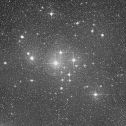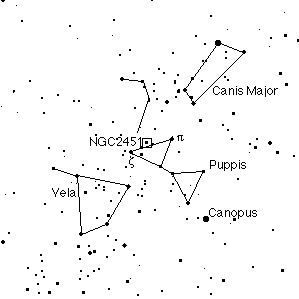NGC2451, an open
cluster in Puppis
 |
 |
 |
A map of the star field. Magnitudes are given without
a decimal point, e.g. 67 is to be interpreted as magnitude 6.7. |
|
How to Find It
Starting from zeta Puppis, move a short distance toward pi. I have successfully
observed the cluster even when the horizon was too hazy for Puppis to be visible with
the naked eye; the unmistakeable asterism around Pi Puppis (see below) can be found
by dead-reckoning from Canis Major, and from there it's only a short hop to Zeta Pup
and NGC2451.
Comments
A favorite of mine, this is one of those broad clusters for which binoculars are really more
appropriate than a telescope.
What makes it unusually attractive is the
contrast in color between the brilliant red star c Puppis in the foreground and the white members
of the cluster,
of which at least five are easily seen.
Northern observers should not be scared away -- this is a nice bright cluster, easily
visible from the southern US at the right time of year.
Nearby Scenery
While visiting the region, a similar colorfest
can be enjoyed in the garish red supergiant Pi Puppis and its three white neighbors.
|
 |
|
60-degree field of view |
| Data (Janes, Duke, and Lynga, 1987) |
| RA | 07 45 |
| dec | -37 58 |
| total V magnitude | 2.8 |
| NGC number | 2451 |
| Trumpler class | II 2 m |
| angular diameter | 50' |
| distance | 315 pc |
| age (Myr) | 36 |
| integrated B-V | .56 |
| observed stars | 153 |
| earliest sp. class | B7 |
| brightest star | 6.0 |
[Top of page
| Up to the BinoSky contents page
]
(c) Copyright 1998 Benjamin Crowell. All right reserved.
Photos from the Digitized Sky Survey, stdatu.stsci.edu/dss/dss_form.html
Sky maps created by Your Sky, www.fourmilab.com





